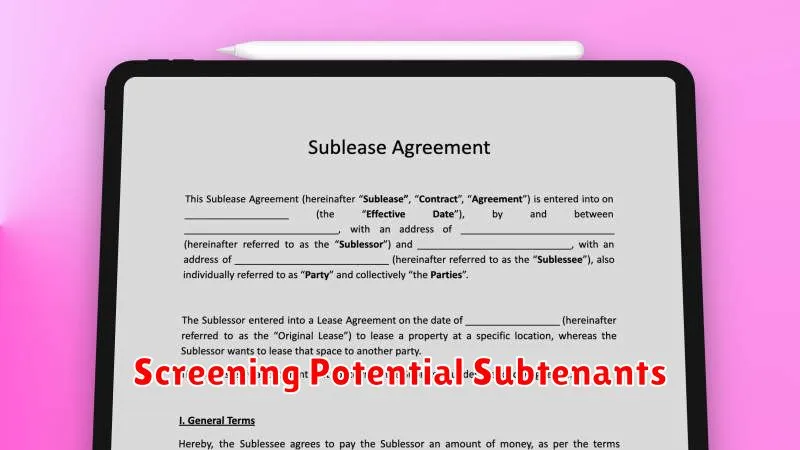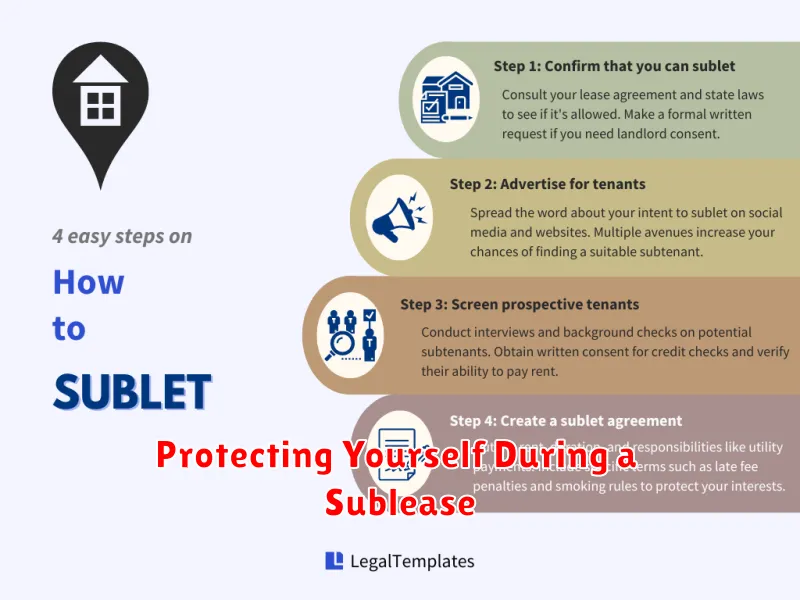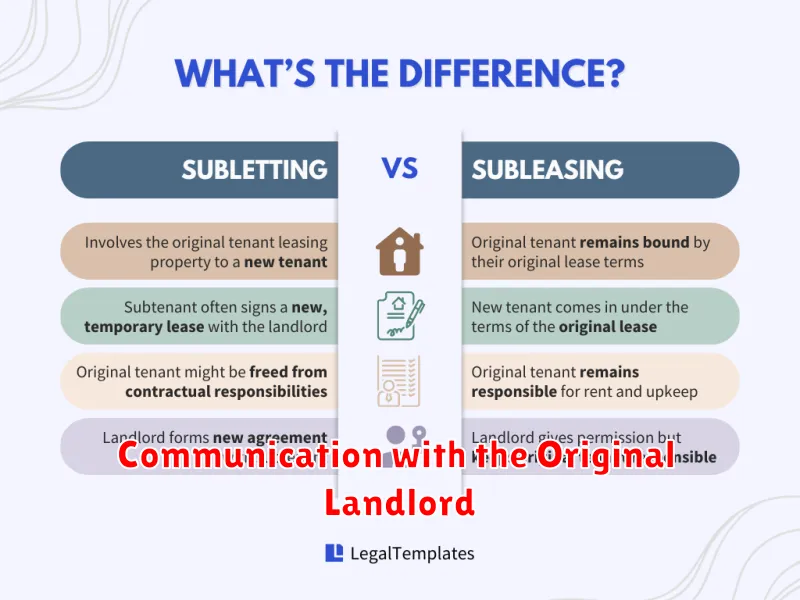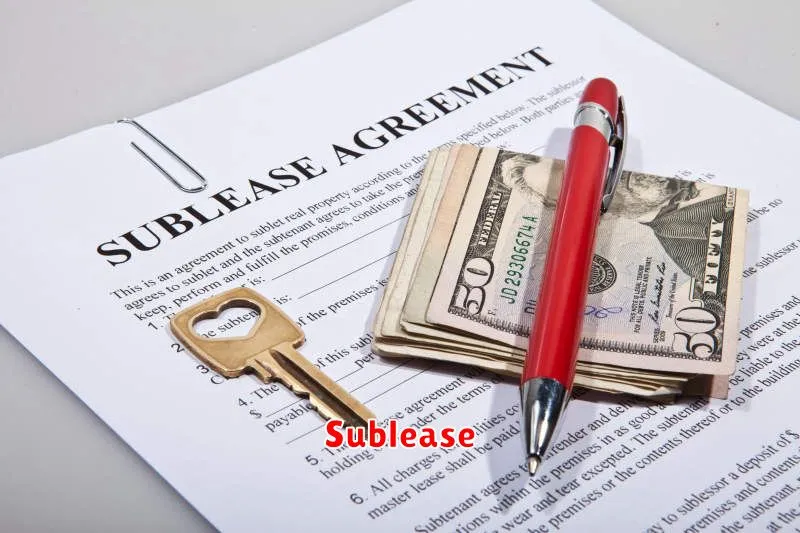Are you looking for a way to save money on your rent or find a more suitable living space without breaking your lease? A sublease might be the answer! This type of lease agreement allows you to transfer your lease obligations to another person, known as a subtenant. In this article, we will delve into the intricacies of subleasing, exploring its benefits and drawbacks. Whether you’re a current renter considering subleasing your apartment or a potential subtenant seeking a new place, this guide will equip you with the knowledge to make an informed decision.
Understanding the Basics of a Sublease
A sublease is an agreement where a tenant (the sublessor) rents out a portion or all of their leased space to another person (the sublessee). The sublessee then pays rent to the sublessor, who in turn continues to pay rent to the original landlord.
Think of it as a nested lease agreement. You have the original lease between the landlord and the tenant (the sublessor), and then you have a separate lease agreement between the sublessor and the sublessee.
The original lease agreement between the landlord and the tenant will typically contain provisions that either permit or prohibit subleasing. If the lease prohibits subleasing, you need to obtain permission from the landlord before you can sublet the property. This is typically done by submitting a written request to the landlord for approval.
Advantages of Subleasing
Subleasing can be a beneficial option for both landlords and tenants, offering a range of advantages. Here are some key benefits of subleasing:
Financial Relief: Subleasing allows tenants to alleviate financial burdens associated with their current lease. By finding a subtenant to take over the remaining lease term, tenants can reduce their monthly rent expenses or even completely eliminate them if the sublease covers the full remaining period.
Flexibility and Control: Subleasing provides tenants with greater flexibility in their housing arrangements. If a tenant needs to relocate, change their living situation, or simply desires a different living environment, subleasing allows them to exit their current lease without facing potential penalties.
Additional Income for Landlords: Landlords can benefit from subleasing by generating additional income. By allowing tenants to sublet their units, landlords ensure consistent rental income throughout the lease term, even if the original tenant moves out.
Reduced Vacancy Rates: Subleasing can help landlords minimize vacancy periods. When a tenant leaves, subleasing provides a quicker way to fill the unit, preventing periods of lost rental income.
Disadvantages of Subleasing
While subleasing can be beneficial in some situations, it’s important to consider the potential drawbacks before entering into an agreement. Here are some of the disadvantages of subleasing:
Liability: As the original tenant, you remain ultimately responsible for fulfilling the terms of your lease agreement. This means that if your subtenant fails to pay rent or damages the property, you could be held liable.
Finding a Reliable Subtenant: Finding a responsible subtenant who will respect the property and fulfill their financial obligations can be challenging. You may need to conduct thorough background checks and references to ensure their reliability.
Potential Disputes: Disputes can arise between you and your subtenant regarding the terms of the sublease agreement, rent payments, property maintenance, or other issues. This can lead to legal complications and strain the relationship.
Limited Flexibility: Subleasing agreements typically include a specific duration, which limits your flexibility to move out of the property if needed. You may need to find another subtenant or face financial penalties if you break the sublease agreement.
Approval from Landlord: Most landlords require their approval before a tenant can sublease their property. The landlord might have specific criteria for approving subtenants and might deny your request.
Before subleasing your apartment, carefully weigh the potential benefits and disadvantages to determine if it’s the right choice for you.
Legal Responsibilities in a Sublease
When you sublease a property, you are essentially renting it from someone who is already renting it from the original landlord. This creates a new layer of legal responsibilities that are unique to the sublease agreement. It’s crucial to understand these responsibilities to protect both yourself and the original tenant.
The most significant responsibility is fulfilling the terms of your sublease agreement. This includes paying rent on time, maintaining the property in a reasonable condition, and adhering to all rules and regulations outlined in the agreement. Failure to do so could result in legal action from the original tenant.
It’s also important to remember that you are not directly responsible to the original landlord. You are obligated to the original tenant, who is then responsible to the landlord. However, your actions as a subtenant can indirectly affect the original tenant’s lease agreement with the landlord.
Finally, you need to be aware of your rights as a subtenant. You are entitled to a habitable living space and should not be subjected to unreasonable restrictions. If your original tenant fails to uphold their responsibilities, you may have recourse under the sublease agreement or local laws.
Understanding your legal responsibilities in a sublease is crucial for a smooth and successful subletting experience. Be sure to thoroughly read and understand the terms of your agreement and consult with a legal professional if you have any questions or concerns.
Reviewing the Original Lease Agreement
Before you even think about subleasing your property, it’s crucial to review the original lease agreement. This is the foundation of your rights and responsibilities as the primary tenant. Look for clauses that explicitly state whether subleasing is permitted. Some leases may have a “no subletting” clause or require the landlord’s written consent for any sublease arrangements.
Beyond the simple permission to sublease, pay close attention to any specific limitations or requirements outlined in the original lease. This could include restrictions on the length of the sublease, the type of tenant allowed, or the rent that can be charged. Understanding these details upfront will save you headaches and potential legal issues down the line.
The original lease also likely dictates your responsibilities as the primary tenant, which remain in effect even if you sublease. This may include things like paying rent on time, maintaining the property, and adhering to the terms of the lease. Ensure you understand these obligations and how they might be impacted by your sublease arrangement.
Finding Sublease Opportunities
Finding a sublease can be a great way to secure affordable housing, especially in competitive rental markets. While you can ask friends, family, or colleagues, there are also dedicated platforms and websites where you can find sublease opportunities.
Online Platforms: Websites like Craigslist, Facebook Marketplace, and Sublet.com often have listings for sublets. These platforms allow you to search based on location, price, and other criteria.
University Housing Boards: If you’re a student or recent graduate, check your university’s housing boards or online forums. Students often sublet their apartments during breaks or when they move out.
Local Facebook Groups: Many cities and neighborhoods have Facebook groups dedicated to housing and rentals. Join these groups and keep an eye out for sublet listings.
Word-of-Mouth: Don’t underestimate the power of word-of-mouth. Let your network know you’re looking for a sublease. They may know of someone who’s subletting their apartment.
Remember, it’s important to verify the legitimacy of any sublease listings you find. Speak to the current tenant and ensure the terms of the sublease are clear and agreeable.
Screening Potential Subtenants

When you sublease your property, you’re essentially becoming a landlord yourself. This means it’s crucial to thoroughly screen potential subtenants to ensure you’re renting to reliable individuals who will treat your property with respect and pay rent on time.
Here are some essential steps to take when screening potential subtenants:
- Check Credit History: A credit check can provide insight into the subtenant’s financial responsibility. A good credit score indicates a higher likelihood of on-time rent payments.
- Verify Employment and Income: Request pay stubs or a letter of employment to confirm the subtenant’s employment status and income. This helps ensure they can afford the rent.
- Conduct Background Checks: Consider conducting background checks, including criminal and eviction history, to assess the subtenant’s past behavior and any potential red flags.
- Check References: Request references from previous landlords or employers to gather firsthand accounts of the subtenant’s character and rental history.
- Personal Interview: Meet with potential subtenants in person to gauge their personality, communication skills, and understanding of the lease agreement.
- Review Applications: Carefully review rental applications for completeness, accuracy, and any inconsistencies that may raise concerns.
- Use a Lease Agreement: Have a comprehensive lease agreement that outlines the terms and conditions of the sublease, including rent payment, responsibilities, and termination clauses.
By taking these steps, you can significantly reduce the risk of subleasing to unreliable or problematic tenants.
Protecting Yourself During a Sublease

Subleasing can be a beneficial option for both the original tenant and the subtenant, but it’s crucial to protect yourself, especially when you’re entering into a sublease agreement. Here are some key considerations:
1. Get Everything in Writing: A comprehensive sublease agreement should clearly outline the terms of the arrangement. This includes the duration of the sublease, the rent amount, any additional fees or charges, responsibilities for utilities, and specific details about permitted use of the property.
2. Understand Your Legal Rights: Familiarize yourself with your rights and responsibilities as a subtenant under your jurisdiction’s landlord-tenant laws. This information can help you ensure your rights are protected throughout the sublease period.
3. Communicate with the Original Tenant: Open and clear communication with the original tenant is essential for a successful sublease. Discuss expectations, responsibilities, and any potential issues promptly and respectfully.
4. Get Landlord Approval (if Necessary): In some cases, the original lease might require the landlord’s approval for subleasing. Always obtain this approval to avoid legal complications and ensure the sublease is valid.
5. Consider Insurance: Depending on your specific situation, you may want to obtain renter’s insurance to cover your belongings and protect yourself from potential liabilities during the sublease.
By taking these precautions, you can increase your chances of a smooth and positive subleasing experience. Remember, a well-structured sublease agreement and open communication with all parties involved are key to minimizing risks and ensuring everyone’s rights are protected.
Communication with the Original Landlord

While you are renting from the sublessor, it’s important to keep in mind that you’re still bound by the terms of the original lease agreement with the landlord. You should be transparent with the landlord about the sublease arrangement and keep them informed of your presence on the property. This can be achieved by:
- Notifying the landlord about the sublease arrangement in writing, preferably with a copy of the sublease agreement. This ensures clarity and a paper trail.
- Maintaining communication with the landlord regarding any issues that may arise, such as repairs or maintenance. This will help to avoid misunderstandings and potential conflicts.
- Being respectful of the landlord’s property and adhering to the original lease terms. While you are renting from the sublessor, the landlord still has the right to access the property for maintenance and inspections.
Keeping the original landlord informed and maintaining a positive relationship will ensure a smooth and successful sublease experience for both parties.

